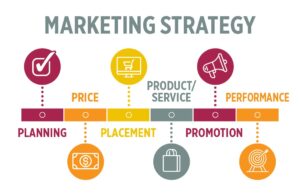A well-defined marketing strategy is essential for businesses to achieve their goals and stand out in a competitive marketplace. It provides a roadmap for your marketing efforts, ensuring that your resources are allocated effectively and your message resonates with your target audience. This comprehensive guide will explore the key steps involved in creating a successful marketing strategy.

Step 1: Define your business goals
- Clearly articulate your objectives: What do you want to achieve with your marketing efforts? Increase sales, build brand awareness, or generate leads?
- Set SMART goals: Ensure your goals are Specific, Measurable, Achievable, Relevant, and Time-bound.
Step 2: Conduct in-depth market research
- Identify your target audience: Create detailed customer personas to understand your ideal customer’s demographics, behaviors, and preferences.
- Analyze your competitors: Evaluate their strengths, weaknesses, and market positioning to identify opportunities.
- SWOT Analysis: Assess your business’s Strengths, Weaknesses, Opportunities, and Threats.
Step 3: Develop a strong brand identity
- Define your brand values: Determine what your brand stands for and what makes it unique.
- Create a compelling brand story: Develop a narrative that resonates with your target audience.
- Design a visual identity: Create a logo, color palette, and typography that reflects your brand personality.
- Establish a brand voice: Define the tone and style of your communication.
Step 4: Set a realistic marketing budget
- Allocate funds for different marketing channels: Determine how much you can spend on advertising, content creation, and other marketing activities.
- Prioritize channels: Focus on channels that align with your target audience and goals.
- Consider return on investment (ROI): Evaluate the potential return for each marketing channel.
Step 5: Choose the right marketing channels
- Content Marketing: Create valuable content to attract and retain customers.
- Email Marketing: Build relationships through personalized email campaigns.
- Social Media Marketing: Leverage platforms to engage with your audience.
- Search Engine Optimization (SEO): Improve your website’s visibility in search engine results.
- Pay-Per-Click (PPC) Advertising: Bid on keywords to display ads on search engine results pages.
- Influencer Marketing: Partner with influencers to reach a wider audience.
- Public Relations (PR): Build relationships with media outlets to generate positive press coverage.
Step 6: Create engaging content
- Develop a content calendar: Plan your content creation and distribution across different channels.
- Create high-quality content: Produce valuable, relevant, and consistent content that resonates with your audience.
- Optimize content for SEO: Incorporate relevant keywords to improve search visibility.
- Utilize visuals: Incorporate images, videos, and infographics to enhance engagement.
Step 7: Implement and track your strategy
- Launch your marketing campaigns: Execute your marketing plan and monitor performance.
- Utilize analytics tools: Track key performance indicators (KPIs) to measure success.
- A/B testing: Experiment with different marketing elements to optimize performance.
- Customer Relationship Management (CRM): Manage customer interactions and data effectively.
Step 8: Analyze and refine
- Review your performance regularly: Evaluate the success of your marketing efforts.
- Identify areas for improvement: Determine what’s working and what’s not.
- Make data-driven decisions: Adjust your strategy based on performance data.
- Set new goals: Continuously evolve your marketing strategy to align with business objectives.
Conclusion
Crafting an effective marketing strategy is a crucial step toward achieving your business goals and ensuring long-term success. Throughout this blog post, we’ve explored essential steps that serve as the building blocks of a robust marketing plan. From conducting thorough market research to defining your unique value proposition, each step is designed to provide clarity and direction in an increasingly competitive landscape. As you embark on your marketing journey, remember that flexibility and adaptability are key. The market is dynamic, and consumer preferences can shift overnight, so be prepared to revisit and refine your strategy as needed. Keep an eye on your performance metrics to gauge the effectiveness of your efforts, and don’t hesitate to pivot your approach based on the insights you gather. Lastly, take the time to invest in a well-crafted marketing strategy—it pays dividends. With a clear plan in place, you can effectively communicate your brand message, engage with your audience, and drive conversions.
